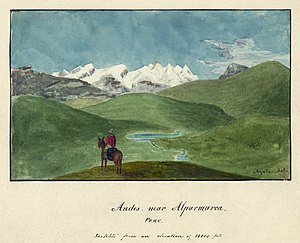United States Exploring Expedition
| United States Exploring Expedition | |||||||
|---|---|---|---|---|---|---|---|
 "Andes near Alparmarca, Peru: Sketched from an Elevation of 16,000 Feet". Illustration by Alfred Thomas Agate from the South American portion of the United States Exploring Expedition, digitally restored. |
|||||||
|
|||||||
| Belligerents | |||||||
|
|
Fiji
Samoa Tabiteuea |
||||||
| Commanders and leaders | |||||||
|
|
Samoa: Malietoa Moli |
||||||
| Strength | |||||||
| 2 sloops-of-war 1 ship 1 brig 2 schooners Marines and Sailors |
unknown | ||||||
| Casualties and losses | |||||||
| ~30 killed or wounded 1 sloop-of-war sunk 1 schooner sunk |
Fiji: ~80 killed or wounded Tabiteuea: 12 killed |
||||||
The United States Exploring Expedition was an exploring and surveying expedition of the Pacific Ocean and surrounding lands conducted by the United States from 1838 to 1842. The original appointed commanding officer was Commodore Thomas ap Catesby Jones. Funding for the original expedition was requested by President John Quincy Adams in 1828, however, Congress would not implement funding until eight years later. In May 1836, the oceanic exploration voyage was finally authorized by Congress and created by President Andrew Jackson. The expedition is sometimes called the "U.S. Ex. Ex." for short, or the "Wilkes Expedition" in honor of its next appointed commanding officer, United States Navy Lieutenant Charles Wilkes. The expedition was of major importance to the growth of science in the United States, in particular the then-young field of oceanography. During the event, armed conflict between Pacific islanders and the expedition was common and dozens of natives were killed in action, as well as a few Americans.
In May 1828, the United States Congress, after prodding by President John Quincy Adams, voted to send an expedition around the world with the understanding that the country would derive great benefit. It was to promote commerce and to offer protection to the heavy investment in the whaling and seal hunting industries, chiefly in the Pacific Ocean. Congress also agreed that a public ship or ships should be used. At the time, the only ships owned by the government capable of such a circumnavigation were those of the navy. So, in fact, Congress had decided that a naval expedition be authorized. The veteran US Sloop-of-war Peacock (1813) was decommissioned and broken down in 1827 to be rebuilt as USS Peacock (1828), intended as an exploration ship. There were to be many unforeseen impediments and it was not until May 18, 1836, that an act was passed, which authorized funding, and approved by President Andrew Jackson, Adams' political rival. Even with the burden of finance lifted, there were another two years of alteration of formation and command before six oddly assorted ships moved down from Norfolk to Hampton Roads on August 9, 1838. On August 17, they were joined by the tenders Sea Gull and Flying-Fish, which delivered Lieutenant Wilkes final orders and at 15:00 on 18 August the vessels weighed anchor. Due to light breezes, the expedition did not discharge their pilots until 09:00 August 19, when they passed Cape Henry Light. By 11:00, the small fleet was standing to open seas.
...
Wikipedia
